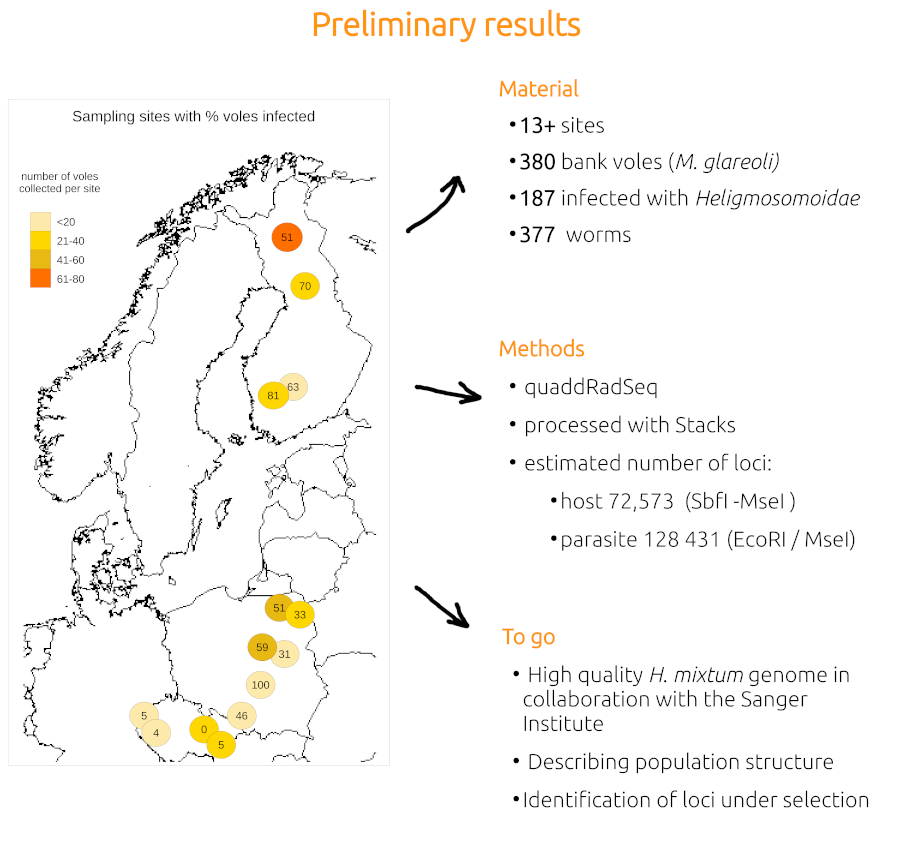NCN grant 2020/39/O/NZ8/01596
“What phylogeography tells us about the evolution of hosts and their nematode parasites?”
In the northern hemisphere, demography and spatial genetic structure of diverse taxa has been shaped by migration patterns after the last glacial maximum. Resulting genetic differences between local populations can be contributed to these demographic processes but also to locally diverse selective forces. The relative importance of these two processes has been widely discussed but despite extensive studies of a handful of genes, little is known about how they affect variation in the genomic scale.
In the proposed project we will address this question by characterizing genome-wide variation of bank voles Myodes glareolus, small sylvatic rodents, and their parasites, the nematode Heligmosomum mixtum. It has been suggested that rodent lineages originating from different glacial refugia may differ in physiological traits such as resistance against oxidative stress or tolerance to low temperatures but recent studies have shown that immunity genes generally did not differentiate between the lineages. This poses a question about the mechanisms of local adaptations that we plan to answer by analysing variance in genomes of their frequent nematode parasite, the nematode H. mixtum. Parasites are an excellent study system for investigating the impact of local selection on host genetic variation due to their direct impact on host fitness, year-to-year stability of local communities, and spatial heterogeneity of the parasite communities. Moreover, parasite population structure may provide an additional information about host population structure and demographic history.
We aim to confirm the post-glacial population structure based on neutral mtDNA markers using genome-wide RADSeq loci. We expect the RADSeq data to reveal a more detailed spatial pattern, possibly revealing new clades. Assuming no host switches, we expect that the parasite structure is stronger than that of their hosts. In both genomes, we expect to find loci under positive and balancing selection that can be linked to host-parasite co-evolution, such as genetic variants associated with given geographic locations.
Research questions:
- Does parasite population structure reflects that of their hosts?
- Are spatial genetic patterns in hosts and their parasites adaptive?
- What are the relative roles of demography and selection in shaping variation in functional loci?
Fieldwork
20 locations, 379 bank voles, 187 infected, > 300 nematodes


Presentations and posters
Abosede E. Olarewaju and Agnieszka Kloch. Optimizing RAD Sequencing protocol for Host-Parasites Phylogeography (Poster presentation) at Population Genetics group conference held between 8th – 10th of January, 2024 at the University of St Andrews, Fife, Scotland United Kingdom.
Olarewaju AE, Kloch A. Host-parasite co-phylogeography: rodents and their nematodes. CNRS Jacques Monod Conference “A matter of scale: Within-host and between-host processes driving coevolution with parasites”, 16-20 October 2023 Roscoff (France)
Kloch A, Olarewaju AE. Host-parasite phylogeography: a tale of glaciation and local adaptations. 56th Population Genetics Group meeting, London, UK, January 2023
Abosede E. Olarewaju Co-phylogeography of Bank voles and its nematode parasites. A short talk at the Landscape and Seascape genomics course at the Department of Marine Sciences, Faculty of Science University of Gothenburg Sweden , 29th of October, 2023.
Abosede E. Olarewaju and Agnieszka Kloch. Co-phylogeography of Bank voles and its nematode parasites. (Online Poster Presentation) at Biodiversity Genomics 2022 virtual Conference held between 3rd – 7th October, 2022, Hinxton Cambridge UK.